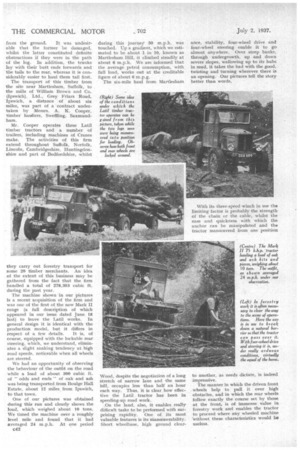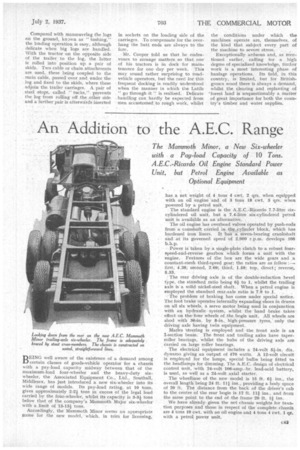Timber Haulage is a Highly Specialized and Particularly Interesting Branch of
Page 87

Page 86

Page 88

Page 89

If you've noticed an error in this article please click here to report it so we can fix it.
the Transport Industry. We Outline Some of the Difficulties, which are Exemplified by a Job We Recently Watched Being Carried Out by a Prominent Suffolk Firm TIMBER haulage may be regarded as comprising three main operations—moving the timber from where it has been felled, loading it on to the trailer and transporting it from the site to the .sawmill. In the early days horses were used exclusively, then, with the introduction of the steam traction engine, this type of locomotive was employed for towing the trailer or drag (sometimes drug) as it was originally called, but the horse was still needed for coping with the logs on the ground.
The traction engine was a slow machine and • its range very limited by both its speed and its water-tank capacity. An advance was made when the smaller and faster team tractor arrived. Its range was greater, but its haulage capacity less and still the horse was indispensable.
Such, briefly, was the position until the advent of • the forestry motor tractor which revolutionized timber haulage. It enabled the horse to be dispensed with, had ample power and was limited in range only by the maximum speed permitted it by law. Now this, too, has been increased to 20 m.p.h., so that many more and longer journeys can be made in a given time.
The development of the pneumatic tyre has also played a big part and cannot be omitted from this story of progress. On both the land and the road it has facilitated the acceleration of those operations dependent on its functions.
A pioneer in the field of forestry c40 haulage, the Latil timber tractor, now occupies a prominent position and is enjoying the fruits of the concentration brought to bear upon its development by its maker, Latil Industrial Vehicles, Ltd., 11, Albert Embankment, London, S.E,11.
Just as in ordinary road transport, the operator may be a haulier, pure and simple, or a concern engaged in some other business running its own vehicles. The true timber haulier confines his activities solely to the operations outlined in our opening paragraph, and is probably employed by the timber merchant, who purchases the timber, has it felled and needs the haulier's service to transport it from where it lies to his sawmill. Alternatively, the , timber merchant may own the necessary equipment and • do this work himself. Timber haulage, however, is indeed a highly specialized trade. One of the biggest'difficulties lies in making a quotation for the cost of the job. Here, wide experience is an indispensable qualification and is one of the chief reasons why' the number of 'concerns engaged in timber haulage is • greater than it is. We surmise that our rpaders will appreciate this difficulty more fully when they: have 'read further into this story.
The timber haulier visits the site; estimates the tonnage (he . actually. work in terms of. cubic -ft:), and 'weighs up • in "-his mind • the specific -difficulties of the job and 'the time it will probably take. Perhaps the hardest 'part is foreseeing the problems that will arise in
eXtricating a ad loading the timber. If the site be accessible to a road matters may he easier, but, even so, the tree trunks may be awkwardly plated and the land boggy or hilly.
An example of an awkward job, is illustrated by the accompanying pictures. Some poplars, one of which weighed over tons, had been felled in a clearing and lay at the foot of a steep, sandy slope'. Near the summit, but separated by rough, sandy ground, fairly thickly overgrown, was the lane to which they had to be moved. • The .tractor could approach the top of the hill up which it had to
'haul: the trunks. •
Matters: were rendered lid easier by a few saplings left . standing by the woodrileO:cind Many stumps protruding
from the ground. It was undesir able that the former be damaged, whilst the latter constituted definite obstructions if they were in the path of the log. In addition, the trunks lay with their butt ends forwards and the tails to the rear, whereas it is considerably easier to haul them tail first.
The transport of this timber from the site near Martlesham, Suffolk, to the mills of William Brown and Co. (Ipswich). Ltd., Grey Friars Road, Ipswich, a distance of about six miles, was part of a contract undertaken by Messrs. A. K. Cooper, timber hauliers, Sweffling, Saxmundbarn.
Mr. Cooper operates three Latil timber tractors and a number of trailers, including machines Of Cranes make. The activities of this firm extend throughout Suffolk, Norfolk, Lincoln, Cambridgeshire, Huntingdonshire and part of Bedfordshire, whilst
they carry out forestry transport for some 20 timber merchants. An idea of the extent of this business may be gathered from the fact that the firm handled a total of 278,353 cubic ft. during the past year
The machine shown in our pictures is a recent acquisition of the firm and was one of the first of the new Mark II range (a full description of which appeared in our issue dated June 18 last) to leave the Latil works. In general design it is identical with the production model, but it differs in respect of a few details. It is, of course, equipped with the lockable rear steering, which, we understand, eliminates a slight snaking tendency at high road speeds, noticeable when all wheels are steered.
We had an opportunity of observing the behaviour of the outfit on the road while a load of about 300 cubic ft. of "odds and ends" of oak and ash was being transported from Boulge Hall Estate, about 12 miles, from Ipswich, to that town.
One of our pictures was obtained during this run and clearly shows the load, which weighed about 10 tons. We timed the machine over a roughly level mile and found that it had averaged 24 m.p.h. At one period
c42
during this journey 30 m.p.h. was touched. Up a gradient, which we estimated to be about 1 in 10, known as Martlesham Hill, it climbed steadily at about 6 m.p.h. We are informed that the average petrol consumption, with full load, works out at the creditable figure of about 6 m.p.g.
The six-mile haul from Martlesham Wood, despite the negotiation of a long stretch of narrow lane and the same hill, occupies less than half an hour each way. Thus, it is clear how effective the Latil tractor has been in speeding-up road work.
On the land, also, it enables .really difficult tasks to be performed with surprising rapidity. One of its most valuable features is its rnanceuvrability. Short wheelbase, high ground clear
ance, stability, four-wheel drive and four-wheel steering enable it to go almost anywhere. Over steep banks, through undergrowth, up and down severe slopes, wallowing up to its hubs in mud, it takes the bad with the good, twisting and turning wherever there is an opening. Our pictures tell the story better than words.
With its three-speed winch in use the limiting factor is probably the strength of the chain or the cable, whilst the ease and quickness with which the anchor can be manipulated arid the tractor manoeuvred from one position to another, as needs dictate, is indeed impressive.
The manner in which the driven front . wheels help to pull it over high obstacles, and in which the rear wheels follow exactly the course set by those at the front, is of immense value in forestry work and enables the tractor to proceed where any wheeled machine 'without these characteristics would be useless.
Compared with manceuvring the logs on the ground, known as " tushing," the loading operation is easy, although delicate when big logs are handled. With the tractor on the opposite side of the trailer to the log, the latter is rolled into position up a pair of skids. Two cable or chain attachments are used, these being coupled to the . main cable, passed over and under the log and fixed to the skids, where these adjoin the trailer carriages. A pair of steel stops, called " tucks," prevents the log from rolling off the other side and a further pair is afterwards inserted in sockets on the loading side of the carriages. To compensate for the overhang the butt ends are always to the fore.
Mr. Cooper told us that he endeavours to arrange matters so that, one of his tractors is in dock for maintenance for one day per week. This may sound rather surprising to roadvehicle operators, but the need for this frequent docking is readily understood when the manner in which the Latils " go through it " is realized. Delicate . handling can hardly be expected from men accustomed to rough work, whilst the conditions under which the machines operate are, themselves, of the kind that subject every part of the machine to severe stress. . , Exceptionally arduous and, as mentioned earlier, calling for a high degree of specialized knowledge, timber work is a most interesting phase of haulage operations. Its field, in this country, is limited, hut for Britishgrown wood there is always a demand, whilst the clearing and replanting of forest land is unquestionably a matter of great importance for both the country's timber and water supplies.




















































































































































